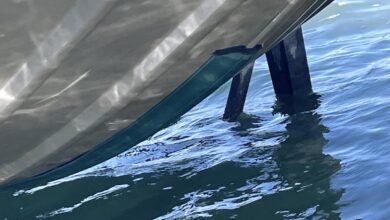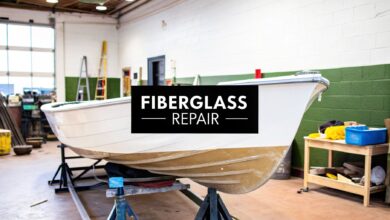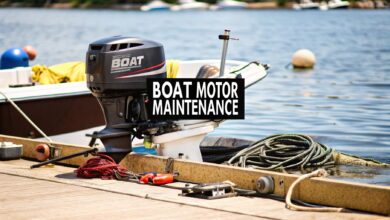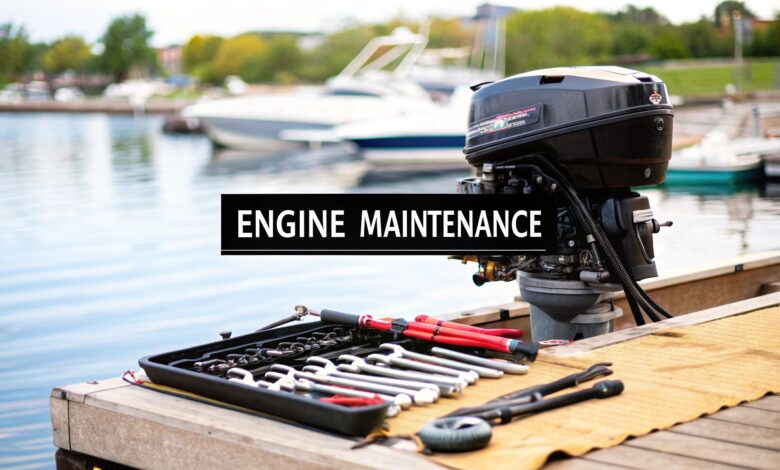
A reliable outboard motor is your best friend on the water. But reliability isn’t a matter of luck; it’s earned through consistent care. Think of outboard engine maintenance less as a chore and more as a proactive strategy.
It’s about catching small issues before they sideline you for a weekend. A good routine can also prevent a repair bill that sinks your budget.
Building Your Core Maintenance Routine

The secret to a long-lasting engine is a solid, repeatable maintenance schedule. Some tasks are quick post-trip habits, while others are deeper seasonal check-ups. Every single one is important.
This isn’t just about making sure the engine starts. It’s about protecting your investment and ensuring your boat is always ready for your next adventure.
Letting this slide has real consequences. I’ve seen engines lose up to 20% of their efficiency due to simple neglect, which often leads to expensive fixes. In the worst cases, it can mean a premature replacement.
Key Maintenance Priorities
A good routine isn’t about doing everything at once. It’s about knowing what to do and when. Getting this rhythm right keeps your engine humming without making you feel overwhelmed.
Here’s what I consider the absolute cornerstones of any good outboard maintenance plan:
- Post-Trip Flushing: This is non-negotiable, especially in saltwater. Always flush your engine with fresh water after every single trip. It’s the single best way to fight off internal corrosion and keep your cooling passages clear.
- Fuel System Care: Modern fuel can be tough on engines. Use a quality fuel stabilizer in every tank to combat ethanol problems. Give your fuel lines a quick once-over for cracks or wear before you head out.
- Regular Fluid Checks: Get in the habit of checking your engine oil and gearcase lube. Stick to your manufacturer’s recommended service intervals for changing them. It’s cheap insurance against major component failure.
- The Annual Service: At least once a year or every 100 hours (whichever comes first), commit to a full service. This is when you’ll replace spark plugs, fuel filters, and—most importantly—the water pump impeller.
Essential Maintenance Tasks At-A-Glance
To help you stay on track, I’ve put together this simple table. It breaks down the most critical tasks by how often you should do them. This gives you a clear roadmap for keeping your outboard in prime condition.
| Frequency | Task | Primary Benefit |
|---|---|---|
| After Every Trip | Fresh water flush | Prevents corrosion and cooling system blockages. |
| Before Every Trip | Inspect fuel lines & prop | Catches potential fuel leaks and prop damage early. |
| Every 50 Hours | Check engine oil & gearcase lube | Ensures proper lubrication and catches water intrusion. |
| Every 100 Hours/Annually | Change oil, filters, spark plugs | Maximizes performance, efficiency, and engine longevity. |
| Annually/Before Storage | Replace water pump impeller & add fuel stabilizer | Guarantees cooling system reliability and prevents fuel degradation. |
Following this schedule takes the guesswork out of maintenance. It turns a potentially daunting list of jobs into a manageable, routine process. This will pay you back with countless trouble-free hours on the water.
Maintaining Your Fuel and Oil Systems
Think of your fuel and oil systems as the heart and arteries of your outboard. Clean fuel and proper lubrication aren’t just suggestions from the manufacturer. They’re absolutely essential for keeping your engine reliable and avoiding internal damage.
When it’s time for an oil change, stick to marine-grade oil. I’ve seen too many engines suffer because someone tried to save a few bucks using automotive oil. It just doesn’t have the right corrosion inhibitors to handle a marine environment.
The same rule applies to your gearcase lube. It needs a marine-specific formula designed to handle extreme pressure and fight off water intrusion.
Checking Fluids and Fuel Lines
One of my best tips is to pay attention to what comes out of your engine. When you drain the old engine or gearcase oil, take a close look. If it’s milky or cloudy, you’ve got water contamination, which points to a failing seal that needs immediate repair.
Finding a lot of metal shavings is another red flag. This signals that something is wearing down internally and needs a closer look.
More often than not, the fuel system is to blame when an engine starts running rough. Make it a habit to regularly replace your fuel filters. This includes both the small one on the engine and the main fuel-water separator on your boat.
You can find more detailed instructions for different systems in our complete guide to boat motor maintenance.
A little prevention goes a long way. Spending a few extra dollars on a quality fuel stabilizer every time you fill up can save you hundreds, or even thousands, in repairs. It’s the best defense against ethanol-related problems like rotted fuel lines and gummed-up injectors.
This simple visual breaks down the flushing process. It’s a non-negotiable step for protecting all your engine’s internal components from saltwater damage.
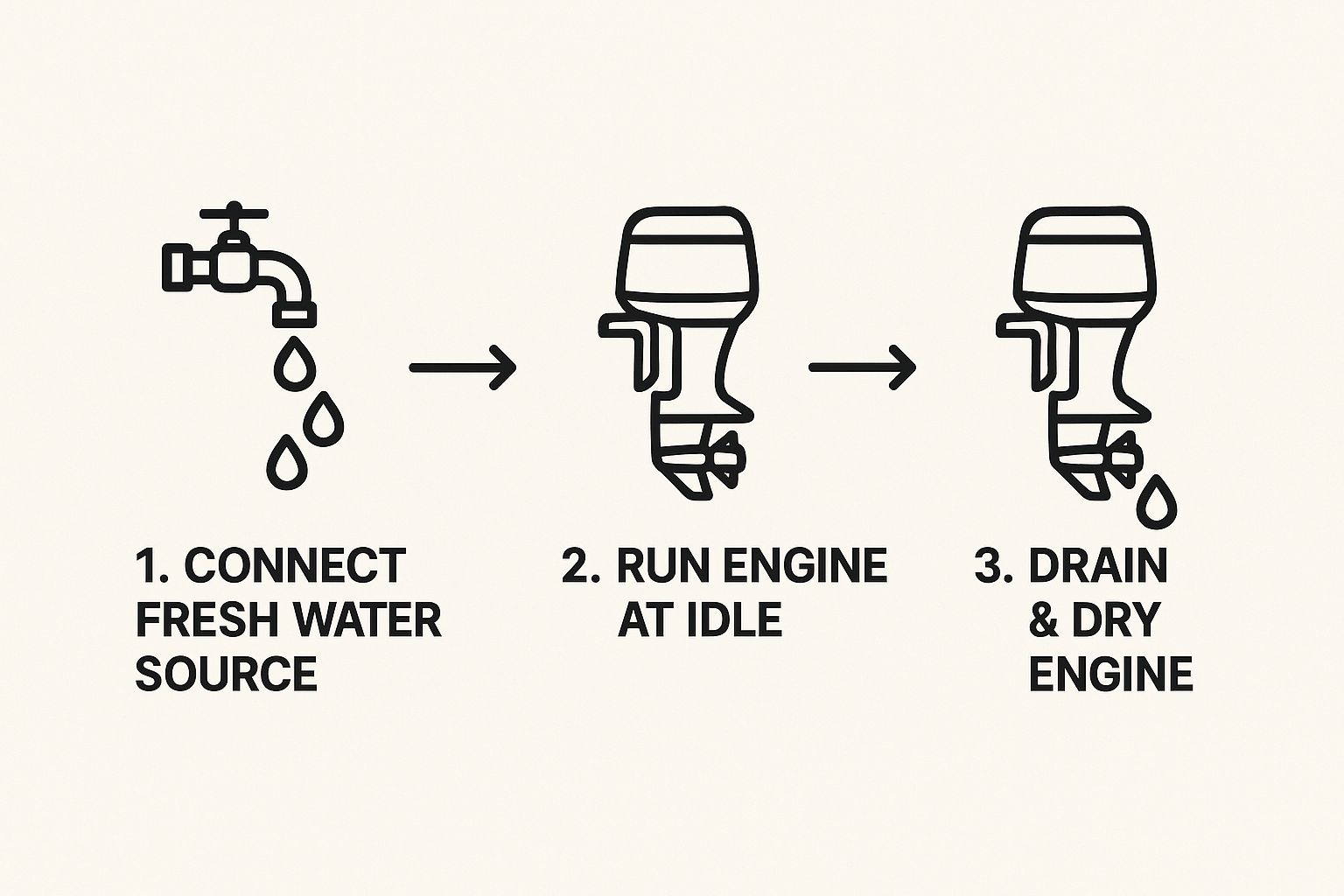
As you can see, flushing your outboard with fresh water is a simple, three-part process. Make it a routine you follow after every single trip—no exceptions.
Servicing the Ignition and Electrical Components

Nothing sours a day on the water faster than turning the key and hearing a weak sputter. When that happens, your electrical system is almost always the culprit. A few simple checks can keep those electrical gremlins at bay.
Spark Plug and Battery Checks
Think of your spark plugs as a report card for your engine’s health. A nice, light tan or grayish-brown color tells you things are running as they should. If you see heavy, black, sooty deposits, your engine is likely running too rich.
An oily residue, on the other hand, might point to more serious internal problems.
Replacing spark plugs is one of the cheapest ways to boost performance. Make sure you gap the new plugs precisely to the manufacturer’s spec using a feeler gauge. The wrong gap can lead to hard starts, misfires, and wasted fuel.
After the plugs, turn your attention to the battery. It’s the heart of your boat’s electrical system, and it needs a little TLC too.
- Scrub the Terminals: Grab a wire brush and clean off any crusty white or greenish corrosion on the battery posts and cable ends. A clean connection is a good connection.
- Confirm Tight Connections: You’d be surprised how often a no-start issue is just a loose battery cable. Give each one a firm wiggle to make sure it’s completely snug.
- Test the Juice: A simple multimeter will tell you everything you need to know. A healthy, fully charged 12-volt battery should read at least 12.6 volts when the engine is off.
Here’s a pro tip I swear by: put a dab of dielectric grease on all your electrical connections—from the battery terminals to the inside of your spark plug boots. It creates a fantastic moisture-proof barrier that prevents corrosion, which is an absolute lifesaver if you do any boating in saltwater.
Your Outboard’s Lifeline: The Cooling System and Propeller
Your engine’s entire defense against a catastrophic meltdown rests on its cooling system. The heart of that system is a small, inexpensive rubber part: the water pump impeller.
Think of this part as mandatory periodic maintenance, not something you wait to fail. I recommend replacing it every 1-2 years, regardless of how many hours are on the engine. The rubber vanes get stiff and brittle with age, and a failure can cause an overheat in moments.
Changing the impeller is a manageable job for most DIYers. The trick is to stay organized and pay close attention when installing the new one. Make sure the vanes point in the right direction as you slide the pump housing back on.
Keeping the Water Flowing and the Prop Turning
Besides the impeller, the single most important habit is flushing your engine after every trip. This is absolutely non-negotiable in saltwater. It prevents salt, sand, and mineral deposits from clogging the delicate cooling passages.
Pro Tip: Keep a close eye on the “telltale” stream every time you run your motor. If that stream looks weak, or worse, isn’t there at all, shut the engine down immediately. It’s a clear signal something is wrong in the cooling system.
Before you head out, also give your propeller a quick once-over. Even small nicks or bent blades can unbalance the prop. This creates vibrations that will eventually destroy your lower unit’s seals and bearings.
While you’re looking, check the prop shaft for tangled fishing line. This sneaky problem can work its way into the propshaft seal. That allows water to flood your gearcase, leading to a very expensive repair.
Seasonal Care for Engine Longevity
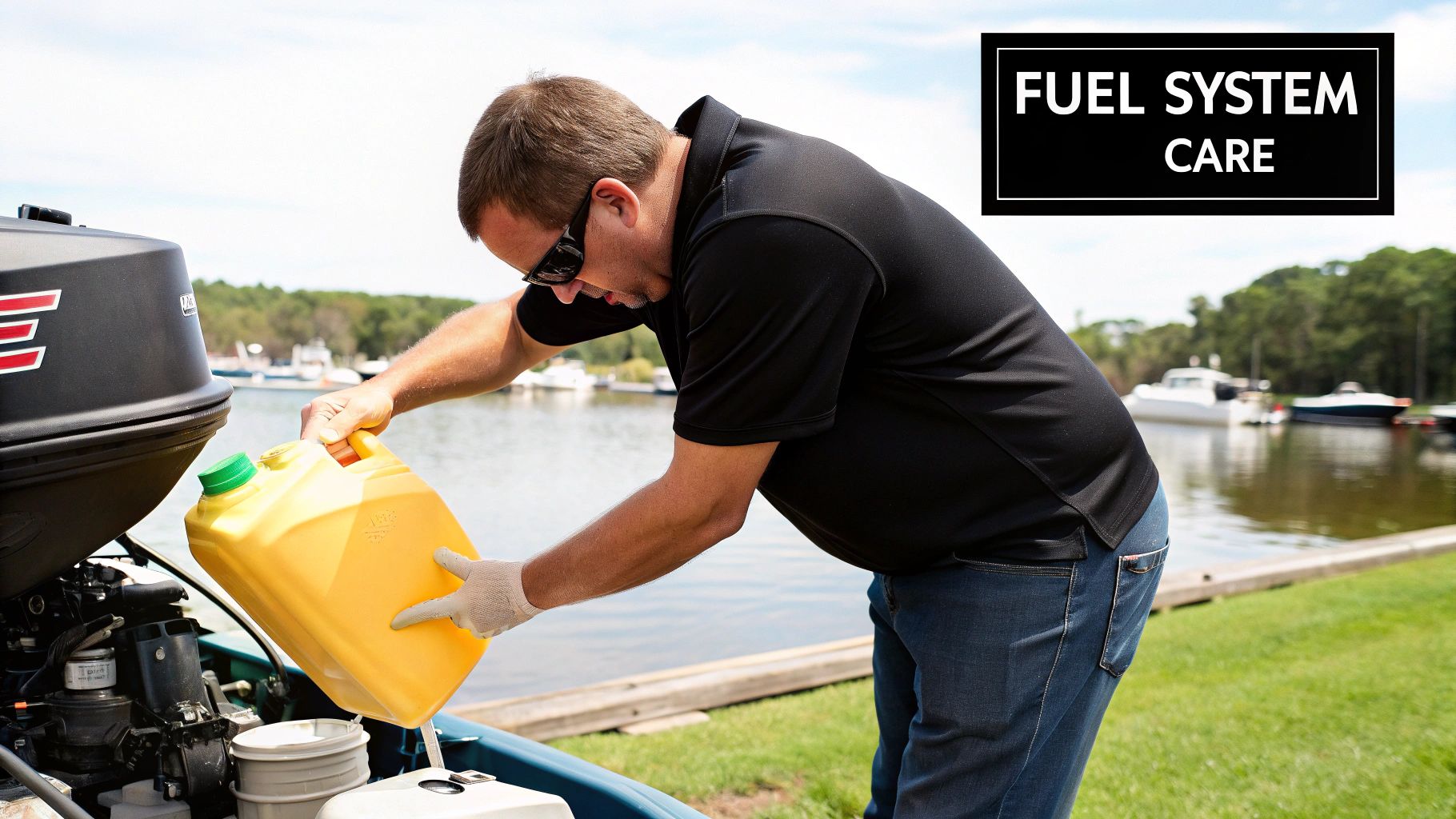
Putting your boat away correctly is probably the most important thing you can do for your outboard engine. If you skip winterization, you’re asking for corrosion and freeze damage. A little effort now saves a world of headache later.
Your biggest enemy during storage is old fuel. Fill your tank almost to the top and add a good quality fuel stabilizer. Then, run the engine for a few minutes to circulate the treated gas through the entire system.
Preparing for Off-Season Storage
With the fuel system protected, the next job is to safeguard the engine’s internals. We call this “fogging” the engine. It involves spraying a special oil into the cylinders to coat the walls and piston rings.
You’ve also got to get every last drop of water out of the cooling system. This prevents catastrophic freeze damage. Once that’s done, think about how you’ll store the motor itself.
- Proper Positioning: Always store the engine vertically, in the normal running position. This is non-negotiable, as it allows any trapped water to drain out completely.
- Battery Attention: Don’t just leave the battery connected. Pull it out, give the terminals a good cleaning, and store it somewhere cool and dry, preferably on a battery tender.
For a comprehensive guide that walks you through every single task, check out our winterize boat checklist.
Waking Your Engine Up for the Season
Getting your engine ready in the spring is just as vital as putting it away properly. It’s not just about mechanical checks anymore. Modern outboards often have sophisticated electronics that might need a look.
Before that first trip to the ramp, reconnect your fully charged battery. Give all the fluids a final check. I always recommend doing a test run at home using a set of “muffs” and a garden hose.
Answering Your Top Outboard Maintenance Questions
Even with a solid maintenance routine, questions always come up. It’s totally normal. Let’s tackle some of the most common questions I get from other boaters.
One of the biggest questions is about how often to service the engine. It’s a great question because sticking to a schedule is your best defense. Following the manufacturer’s lead here will keep your motor humming for years.
The gold standard is to service your outboard annually or every 100 hours of use, whichever comes first. Think of this as the bare minimum. It’s what most manufacturers require to maintain engine health and keep your warranty valid.
What Are the Telltale Signs of a Failing Water Pump Impeller?
The classic sign is a weak or absent stream of water from the “telltale” outlet port. That’s your engine’s way of telling you it’s not cooling properly. You might also get an engine overheating alarm on your console.
If you notice either of these, shut the engine down immediately. Overheating can cause catastrophic damage in a hurry.
The best approach is to be proactive. I recommend swapping the impeller every one to two years. It’s cheap insurance against a total failure.
Can I Just Use Car Oil in My Four-Stroke Outboard?
I hear this one a lot, and the answer is a hard no. This is one of the most critical things for your engine’s long-term health.
You absolutely must use a marine-grade four-stroke oil rated FC-W (Four-Cycle Water-cooled). Car oil doesn’t have the anti-corrosion additives needed for a marine environment.
Using the wrong oil is an expensive shortcut that will cause accelerated wear. If you want to dive deeper into service schedules, check out our guide to outboard motor maintenance.
At Boating Articles, we’re passionate about sharing the expert knowledge you need for a better life on the water. From DIY fixes to finding the perfect gear, our guides are designed to help you boat with total confidence. Explore more of our hands-on tips and in-depth reviews at https://boating-articles.com.

